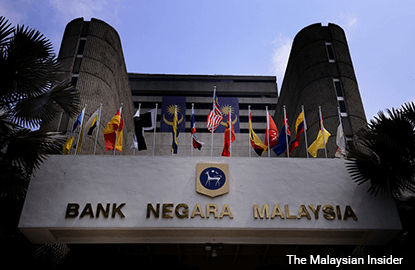
This article first appeared in The Edge Financial Daily, on December 28, 2015.


KUALA LUMPUR: Malaysian banks may have to endure another period of weak credit cycle next year, as loan growth is expected to decelerate, which would result in slower money creation, according to analysts.
Credit cycle is the expansion and contraction of access to credit over a period of time.
“The credit cycle in Malaysia was very strong up to 2012. [In fact] it had been overly strong. I suppose this year has marked the end of that credit cycle. We expect loan growth to be slower next year, with net interest margin (NIM) continuing to be compressed,” Inter-Pacific Securities Sdn Bhd head of research Pong Teng Siew told The Edge Financial Daily.
Based on Bank Negara Malaysia’s monthly data, Malaysia’s total loan growth has been slowing since as early as July 2012. Though the numbers increased moderately a year later, they continued to be subdued from January 2014 onwards.
Pong said that the fatigued loan growth is slowing down the banking system’s money creation process.
“At this point, banks are not only competing for creditworthy clients, they are also putting more emphasis on deposit levels, as they are seeing their loan-to-deposit ratios (LDRs) climbing,” he said.
LDRs are used to assess a bank’s liquidity by dividing the bank’s total loans by its total deposits. If the ratio is too high, then the bank may not have enough liquidity to cover unforseen fund requirements. If the ratio is too low, it may not be earning as much as it could be.
Nevertheless, Pong does not expect deposit interest rate to surge drastically in 2016 as Malaysian banks need to juggle their offering rate with cost of fund, to maintain sustainable NIM.
During the third quarter ended Sept 30, 2015 (3QFY15), all nine Malaysian banks saw their net LDRs rise between 0.2 and 8.8 percentage points.
On Dec 15, Fitch Ratings revised the sector outlook for Malaysian banks to negative in 2016 due to greater pressure on earnings and asset quality.
It forecast gross domestic product (GDP) growth to ease to 4.4% in 2016 from 4.7% this year, with a potential for further downside.
“Consumer and business confidence has declined, suggesting further softness in domestic demand, if prolonged. Relatively high household debt [88% of GDP at end-2014] may make consumers even more cautious in an uncertain economy.
“[As such,] our negative banking sector outlook incorporates some downside risk to current economic growth forecasts,” it said in the report “2016 Outlook: Asia-Pacific Banks”.
Fitch also sees some borrowers facing difficulty in adjusting to the significant currency depreciation over the past 12 to18 months. “We believe these developments translate into lower loan growth and higher credit costs in the next one to two years,” it said.
The agency also expects the recent rise in non-performing loan formation to continue into 2016.
“Delinquencies over the past 12 to 18 months have largely been from troubled industries offshore, such as the commodity sector in Indonesia, but we expect deterioration in banks’ domestic portfolios to emerge in 2016,” it said.
Meanwhile, Kenanga Research’s analyst Ahmad Ramzani Ramli also sees little catalysts to stimulate loan growth in 2016.
“So far, we have not seen any catalyst for 2016, unless the economy recovers. Maybe if 2QFY16 and 3QFY16 economic data turn encouraging, then banks may have more confidence to approve loans,” he noted.
Nonetheless, it is not all dark and gloomy to Ahmad Ramzani, who noted that with the stringent loan approval since 2014, Malaysian banks may now have a better-quality loan portfolio.
“If their quality of loans gets better, it may give room to banks to be less stringent in terms of loan approval,” he said.
However, an analyst, who declined to be named, said 2016 will be the time to reflect on banks’ loan quality, particular those that were approved before the abolishment of the Developer Interest Bearing Scheme (Dibs).
“This is the time to test those loans approved during the Dibs period, because some of these loans may have been taken for the purpose of leveraging. We will see now if they really have the strength to repay these loans,” she said.
Despite the fact that there are little upside catalysts for the banking sector, Ahmad Ramzani said he would still choose Malayan Banking Bhd (Maybank) as his stock pick, mainly due to the group’s Asean exposure and attractive dividend yield.
“Maybank has a balanced exposure to the region, and with a dividend yield of about 7%, PE (price-to-earnings ratio) of 1.3 times compared with the industry’s average of 1.5 times, I think it is a good deal,” he said.
Pong concurred, adding that on top of its valuation, Maybank has demonstrated robust profit growth in the past.
For 3QFY15, Maybank posted a net profit of RM1.9 billion, up 18.1% year-on-year from RM1.61 billion, while net interest income came in at RM2.9 billion, 17.7% higher from RM2.46 billion seen in 3QFY14.
However, Maybank Investment Bank Research analyst Desmond Ch’ng is more attracted to banks that possess liquid balance sheets.
“Our preference would be for banks with liquid balance sheets to better withstand price competition, thus our ‘buy’ calls are on AFG (Alliance Financial Group Bhd), BIMB (BIMB Holdings Bhd) and Hong Leong Bank Bhd/Hong Leong Financial Group Bhd, that have net LDRs of 85%, 81% and 80% respectively, as at end-Sept 2015,” he said.
In his research report dated Dec 3, Ch’ng also mentioned that banks’ return on equity are expected to compress further.